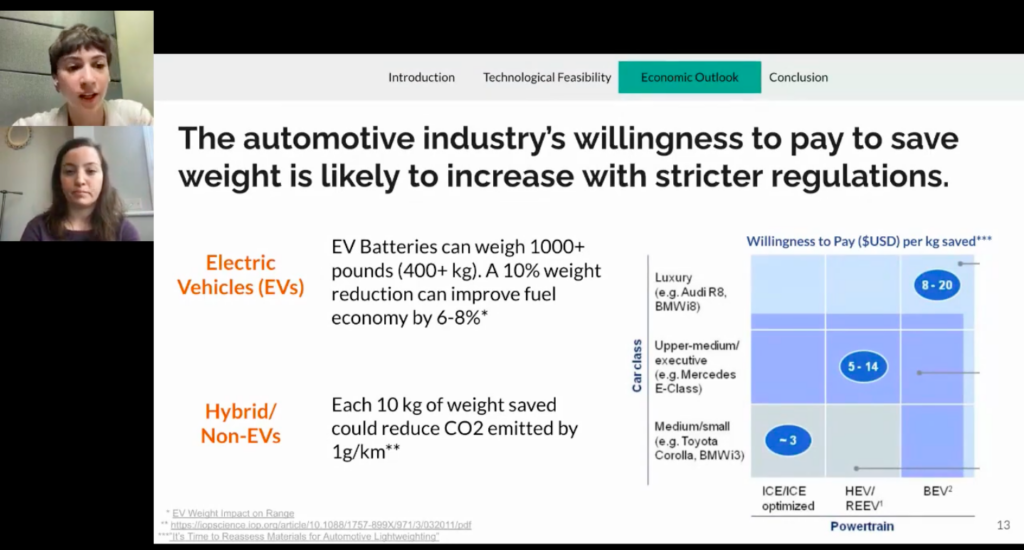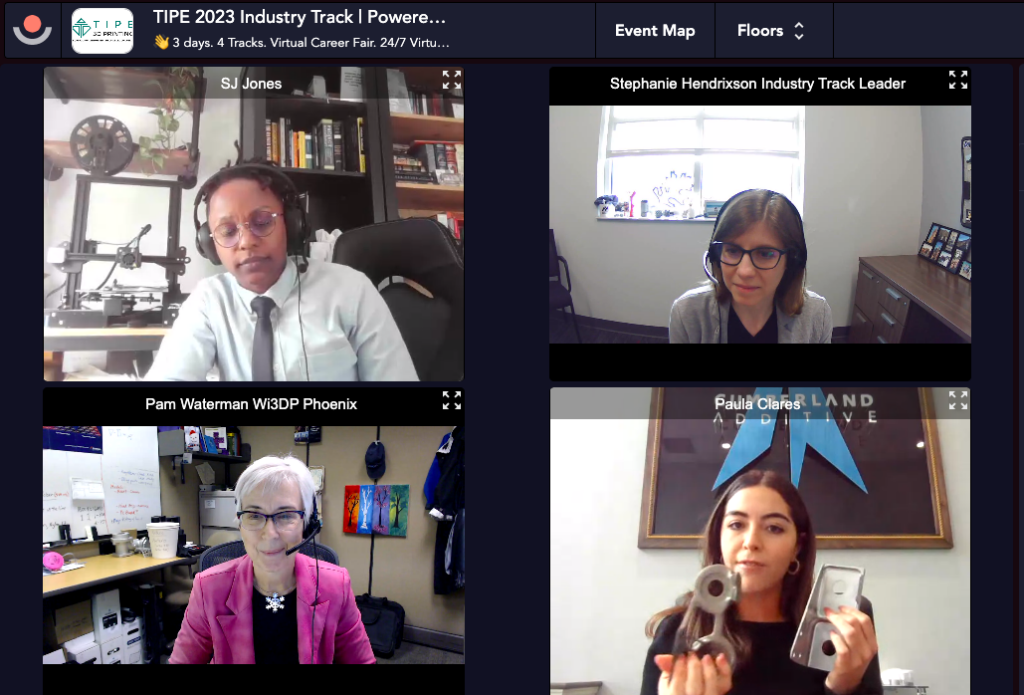As discussed in a previous article on the event, the TIPE 2023 event from Women in 3D Printing (Wi3DP) was replete with sessions dedicated to key developments in the additive manufacturing (AM) industry. Two such sessions were “Production AM for Critical Applications,” and “Sustainability of Carbon Fiber Reinforced Plastic (CFRP) in Additive Manufacturing,” both of which demonstrated how mature the industry has become since I first began writing about it over a decade ago.
New 3D Printing Opportunities with Recycled Carbon Fiber
In her talk, “Sustainability of Carbon Fiber Reinforced Plastic (CFRP) in Additive Manufacturing,” Heather Nelson, Mechanical Engineer at Arevo, discussed how 3D printing can repurpose disused carbon fiber, 30 percent of which ends up in landfills. Recycling these materials is difficult, in part because the matrix polymer that holds the carbon fiber can be difficult to separate from the reinforcement material itself.
Another issue is that carbon fiber can be weaker upon recycling. Nelson indicated that reclaimed fiber that is over 7mm long will retain at least 80 percent of its theoretical maximum strength. However, the length currently used in chopped carbon fiber, the dominant variety in 3D printing, measures only 100 microns in length.
According to Nelson, the total number of companies who are focused on 3D printing CFRP, including her own, have raised $630 million in funding. They are all tailored to a variety of 3D printing processes and materials, with some focused on continuous carbon fiber and some chopped. Because recycled carbon fiber will cost 20 to 40 percent less than virgin materials, while retaining a good deal of strength, there’s a lot of value to be had there.
She discussed how the automotive industry would likely be the sector to immediately benefit from these developments the most, mentioning government initiatives to drive down emissions from vehicles. In turn, manufacturers will turn to 3D printing and recycled carbon fiber to lightweight vehicles at a reduced cost. On the supply side of the equation, Nelson said that “35 million vehicles enter their recycling industry every year. 12,000 planes will retire over the next 20 years, and once the carbon fiber-related ones start retiring, there will be a huge supply of end use carbon fiber composites ready for recycling.”
3D Printing for Critical Applications
3D printing CFRP for the automotive sector would actually be one demonstration of the use of AM for critical applications, a separate topic discussed by a group on a separate panel. However, much of what was discussed there went above and beyond automotive, looking at 3D printing for such high-performance applications as new space and aerospace.
The panel begin with each member introducing parts they’d made that served critical functions for customers. In the case of Paula Clare, additive manufacturing engineer at Cumberland Additive, this was a bracket for Airbus, which had been first simply reproduced with 3D printing and then optimized taking advantage of the design flexibility and weight savings possible with the technology. Pam Waterman, 3D printing application engineer at Phoenix Analysis and Design Technologies (PADT), highlighted a fixture made for Boom Supersonic 3D printed with a Stratasys system and used to attach special tiles onto the aircraft. SJ Jones, technical sales engineer at Velo3D, mentioned the compressors and impellers that the company is able to produce with very low overhangs.
They went on to discuss the challenges of integrating AM into performance applications, including the narrow range of material allowables certified for 3D printing compared to traditional processes, as well as the range of materials themselves. Jones pointed out that designing for AM or even selecting 3D printing as a manufacturing technology can move in the opposite direction as conventional techniques.
“When you work in additive applications, you think ‘last step backwards.’ Normally, the last step is quality and involves: ‘How am I going to verify that it is what it is, that it’s all the way solid, it’s all the way dense, it’s going to perform the way I need it to, what tests am I going to run?’ Then you walk backwards from that. I have customers that will design these like super thin walls and then they’ll get to the end, and they’ll be like, so is it good?” Jones said. “A lot of customers are getting bitten because they jumped the gun and don’t think about how they’re going to assess the quality of a part after it’s printed, in terms of inspection.”
Waterman suggested that there is a gap between the current state of the technology and what the market is demanding of it. This includes issues that range from scaling up the processes for production to tracking data, handling IP, and more. She finds that customers just aren’t aware of all that it would take to establish a 3D printing factory.
These ideas carried over into the learning curve faced by customers, such as the materials available in thermoplastics compared to thermosets and how those materials can be treated and for what applications they make sense. Even those from the AM world will have to come to terms with what is possible with newer processes like that from Velo3D, where one can go well beyond 45-degree overhangs.
While the learning curve is one issue to contend with, establishing an entire workflow for serial production is something else altogether. To do so, it’s necessary to setup material tracking for the necessary traceability, select the right build file type (STL, 3MF, etc.), and lock in the file and machine parameters for mass manufacturing of a given part. Clare highlighted how standards, such as ASTM 529 for aerospace PBF, will delineate all of the necessary details for 3D printing for a critical application, giving users some guidance into what’s required for serial production.
Jones provided a somewhat contrarian take here, saying that, though it is possible to track absolutely everything in a production workflow, it may price some potential users out of AM.
“Every aerospace company has a different standard that they want you to hold to. And then you have to come up with this fancy quality system to track all of it and maintain all of it. And that quality system can be expensive. So, for small to medium-sized businesses that are getting into additive—especially with the at-home manufacturing that we’re seeing pushed for—I worry that they’re going price themselves out,” Jones said. “For example, I’ve seen service bureaus adhere to ASTM 9100 quality standards. That’s an aerospace quality standard, which is great and all, but it’s very strict, very regimented. It takes a lot of labor to maintain it, keep up with it, and track everything through it. Maybe you have a customer that comes to you for a little, rinky-dink prototype that’s going to cost maybe $10,000. You don’t really care about all the aerospace stuff, but because your system is set up for that, you have to track it and put all the labor into it. It may not be cost-advantageous because you have to raise your prices to maintain that quality. So just understanding what you need to track, what’s important and really focusing on that.”
That last point also speaks to what 3DPrint.com Executive Editor Joris Peels has been discussing related to the commoditization of metal 3D printing. While a Velo3D machine with eight lasers may be key for an aerospace manufacturer, something lighter and less expensive could work for another firm, where standards aren’t so stringent.
Conclusion
Naturally, these are only minor glimpses into the experience of TIPE 2023. There were plenty of other things to learn. For instance, Jennifer Killingback, Director of North America at Alexander Daniels Global, provided advice to jobseekers, which ranged from keeping one’s LinkedIn account professional to formatting a resume in the most eye-catching manner.
The talks also took place across entire days, meaning that I didn’t get a chance to see presentations from folks on the other side of the planet. Fortunately, Wi3DP is uploading the various sessions to YouTube, so that we can revisit the wealth of content that came out of the event. Unfortunately, it means that those who didn’t attend, won’t get the full experience of interacting with others at the networking booths or exploring the Virtual Job Fair, where I saw recruiters discussing some really exciting employment options on a rolling basis. However, the individuals who couldn’t make it will be able to attend TIPE 2024 next year.
Feature image courtesy of Velo3D.
Subscribe to Our Email Newsletter
Stay up-to-date on all the latest news from the 3D printing industry and receive information and offers from third party vendors.
Print Services
Upload your 3D Models and get them printed quickly and efficiently.
You May Also Like
Reinventing Reindustrialization: Why NAVWAR Project Manager Spencer Koroly Invented a Made-in-America 3D Printer
It has become virtually impossible to regularly follow additive manufacturing (AM) industry news and not stumble across the term “defense industrial base” (DIB), a concept encompassing all the many diverse...
Inside The Barnes Global Advisors’ Vision for a Stronger AM Ecosystem
As additive manufacturing (AM) continues to revolutionize the industrial landscape, Pittsburgh-based consultancy The Barnes Global Advisors (TBGA) is helping shape what that future looks like. As the largest independent AM...
Ruggedized: How USMC Innovation Officer Matt Pine Navigates 3D Printing in the Military
Disclaimer: Matt Pine’s views are not the views of the Department of Defense nor the U.S. Marine Corps Throughout this decade thus far, the military’s adoption of additive manufacturing (AM)...
U.S. Congress Calls Out 3D Printing in Proposal for Commercial Reserve Manufacturing Network
Last week, the U.S. House of Representatives’ Appropriations Committee moved the FY 2026 defense bill forward to the House floor. Included in the legislation is a $131 million proposal for...



































